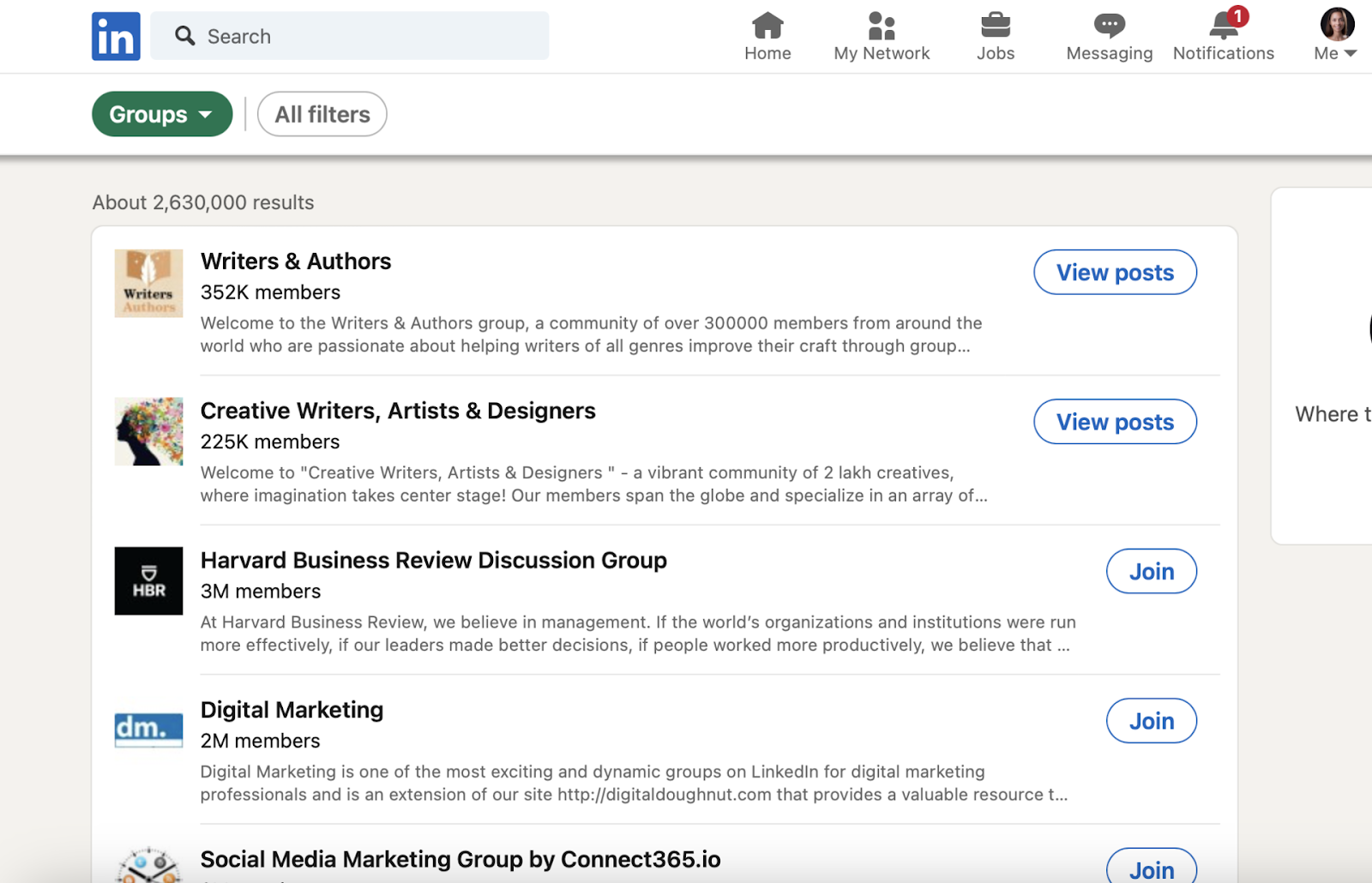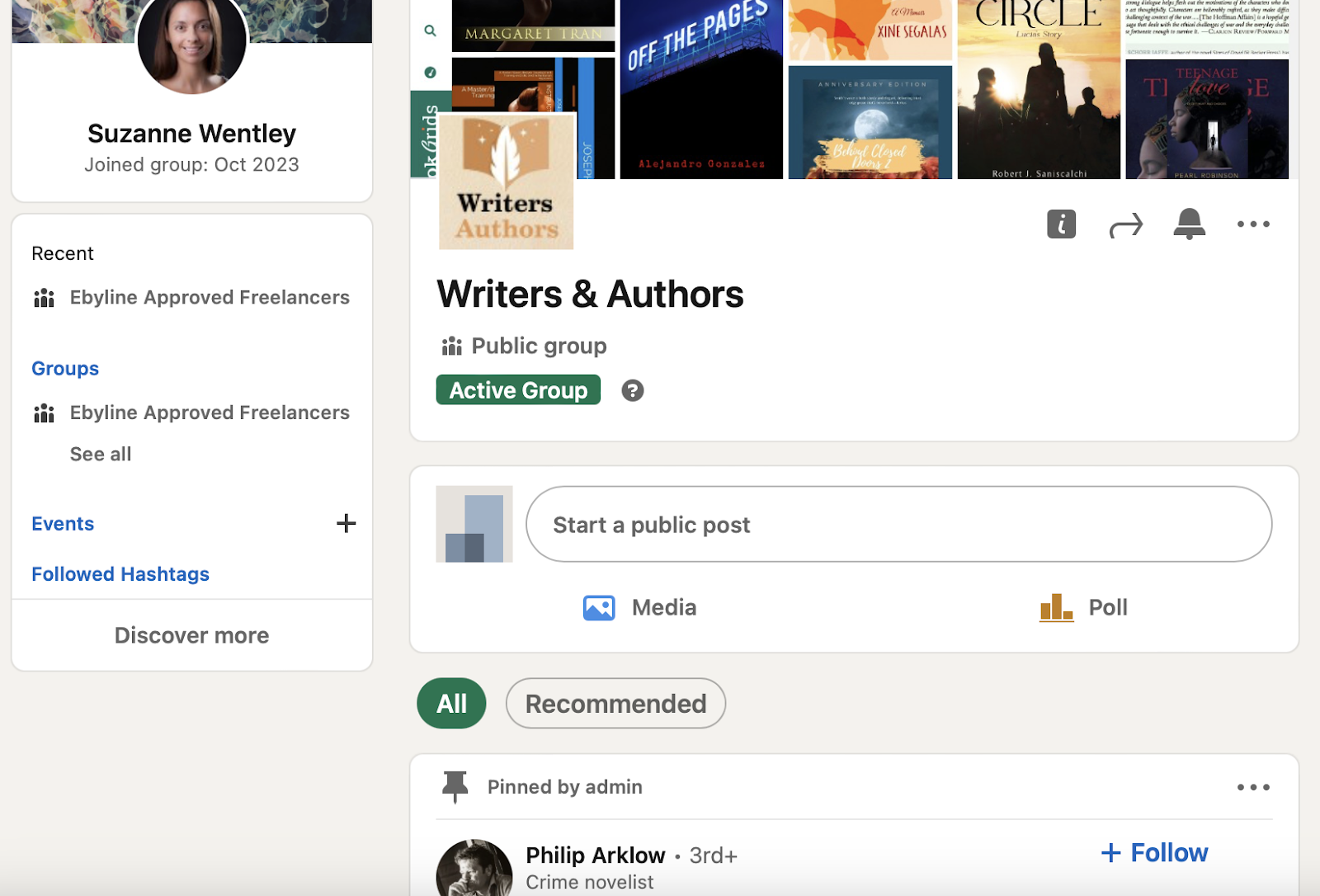
I think of my LinkedIn news feed as the digital equivalent of attending a chamber of commerce networking breakfast — except I don’t have to wear a suit and heels at 7:30 a.m. while hearing what’s new with my fellow professionals.
I get to catch up with the professional contacts I’ve established through my career, and I can see how people from a variety of industries use the social media platform to stay top-of-mind, position themselves as thought leaders, and share valuable tips, opinions, and resources.
If LinkedIn is like a chamber of commerce breakfast, then LinkedIn groups are similar to break-out committees of like-minded professionals from the biggest chamber of commerce in the world. When you join and are active in LinkedIn business groups, you’ll have found a new place to share content and expand the reach of your business. It’s an organic social media marketing strategy that’s worth exploring.
LinkedIn, as a social platform, dates back to 2003, but it started to grow in 2016 when Microsoft bought the company. It boasts 950 million members in 200 countries around the world — which is way too many people to buy coffee and doughnuts for, anyway.
When professionals join LinkedIn, they hand out their virtual business cards. But as anyone who has spent time networking in real life knows, more must happen to get new customers or land a deal. There needs to be follow-up and additional touch points to help prospects gain trust and confidence in whatever you’re selling. That’s where LinkedIn public groups come in.
And then there are LinkedIn private groups. In the chamber of commerce analogy, private groups on this social media page are like getting on the exclusive board of a committee. You must be invited to join by the organizer, or you can create your own. These private groups can be an internal tool or ways to deepen relationships among various professionals.
Introduction to LinkedIn groups
LinkedIn groups are curated communities where people can share ideas, content, and other posts.
A quick search of my LinkedIn reveals about 47,000 groups that I can request to join. There are a few ways you can find groups from your business LinkedIn profile. You did create a LinkedIn company page, right? Although every business owner and team member should have their own page on this professional platform, having one specifically for the company is a good practice, too.
You can use your company’s LinkedIn page to join groups just like you can with your personal profile. There are benefits of networking within LinkedIn from both directions. A company page can be especially effective for business-to-business, or B2B, marketers and clients, while LinkedIn marketing can be successful if you connect relevant personal posts with your brand.

The advantages of LinkedIn groups
LinkedIn groups are great places to learn about important industry trends and ideas. They’re also an attention marketplace for small- and medium-sized business owners. As you likely know, the first step to any strategic outreach plan is an understanding of your audience. Then, you target your audience using data and present personalized messaging.
With 202 million LinkedIn users in the United States alone, groups let you refine and support your audience. Here are some ways you can benefit from using groups on this professional social media platform.
Networking opportunities
While those networking breakfasts are still a good way to connect with professionals in a geographic community, the reality is that business is now global. No matter how small a company is, its digital reach doesn’t have to be limited to driving distance. That’s why it’s important to have networking opportunities that extend far, too.
Groups give you the chance to interact with fellow professionals from your industry as well as prospects who can benefit from your products and services. Once you’re a member of a LinkedIn group, you can post and share content with members of that group. When you provide thoughtful analysis, ideas, or even humor to a post, you’re connecting with like-minded people in a meaningful way. With time, you can use that connection to send new network requests.
Thought leadership
LinkedIn groups are a great way for B2B marketers to offer valuable ideas that shape conversations in their industry, highlighting their authority and relevance.
When you want to stand out on LinkedIn, actively participating in relevant groups can help you gain traction as a thought leader in your industry. Most entrepreneurs and seasoned professionals have experience worth sharing with their colleagues and like-minded individuals. To establish thought leadership, you want to show yourself as an industry expert. This is simply a matter of planning and writing blogs on topics you know the people in your groups will care about.
To brainstorm these topics, think about common questions in your industry or business. What does your audience want to know? When you share your wisdom for free in groups, you’ll see a return on investment through your thought leadership. Your fellow professionals will start to see you — and your brand — as the obvious pick for doing business together.
Targeted audiences
Identifying your target audience is one of the most important things you can do when creating a LinkedIn marketing plan. But refining that focus takes some digging into the data and truly understanding the needs, habits, and pain points of your current and future customers.
When you join groups on LinkedIn, you can focus on a smaller audience. It’s also an opportunity to listen and learn more about them. That’s the best way of both refining your message and your operations.
Content sharing
If you already have a blog, what are you waiting for? LinkedIn groups are ideal for sharing relevant content as part of a vertical content distribution plan. For example, when you share blog posts in a group, you draw fellow professionals to your site simply by offering interesting content.
Of course, there are plenty of other kinds of content to share through groups, too. Along with written blogs, white papers, and case studies, you can create and share infographics, videos, podcasts, and more. The more visually creative and appealing a piece of content is, the more viral it will be on LinkedIn.
Market research
Just as you can learn about your audience through groups, you can also learn about your target market. In the right group, you can monitor the competition, identify new needs as they arise, and stay up to date on the latest trends. Groups help you track the industry from as local or as global of a perspective as you choose, depending on which groups you join.
How to get started on LinkedIn groups
Let’s get into some LinkedIn 101. You’ll want to have both a personal LinkedIn page along with a LinkedIn page for your company. Now that so many companies have a robust online presence with Facebook Business pages, Google My Business, and other social media platforms, this dual system won’t be as strange as it might have been 10 years ago. But even with the 61 million companies on LinkedIn, it may still feel like LinkedIn is an underutilized platform — and that’s a good thing. You can be a big fish in a relatively smaller pond, especially when you join the right groups.
Optimize your LinkedIn profile
To have a business page on LinkedIn, you’ll first need a personal page. This is similar to setting up a Facebook Business page, which is another avenue to use social media marketing to grow your business.
Signing up for a profile is just the beginning, of course. For personal pages, use a professional headshot for the profile picture and choose a banner image that gives your professional network a look at your humanity.
Then, follow these best practices for a great profile.
- Integrate keywords that your target audience uses in searches for your products or services.
- Craft an attention-grabbing headline.
- Provide a detailed and enjoyable profile summary using the tone and voice of your brand.
- Start to grow your social network with people you know personally and professionally.
- Request recommendations from your contacts — and give them out, too.
- Exhaustively fill out the skills section.
- Add a resume.
- Include a link to your company’s website.
To create a company page, start at your personal home page. You’ll see a small nine-dot icon next to the “Me” icon on the top right that reads “For Business.” From there, you can click on “Create a Company Page” and follow the prompts. Use your official business logo for the profile pic and upload a photo of products, your business storefront, or even the Little League team your company supports for the banner.
For company profiles, you won’t need to add the resume — but think about other documents that could be of service to potential customers. For example, a certified public accountant may want to include a case study on a client they helped usher through a difficult IRS filing. Or, if you work in the wellness industry as a bodywork therapist, provide a list of services and prices. Try to answer all questions before they’re asked.
Find relevant groups
Once your profiles are glowing, you’re ready to reach out and expand your network using LinkedIn groups. Knowing how to find groups on LinkedIn takes some strategy, but you can begin by simply browsing the thousands of options.
To find interesting groups, you can enter relevant keywords in the search bar on the upper lefthand corner, then click the “Groups” button on the top of the screen. Alternatively, view your groups via the “Groups” link on your left-hand toolbar on your home page, then scroll through suggested groups by clicking on “Search other trusted communities that share and support your goals.”
As you begin your search, be open to joining many different ones before you settle into the groups that are most active and engaging. The best groups may not necessarily be the ones with the most members. Just like on other social media platforms, you may have to experiment first.
There’s no secret about how to join groups on LinkedIn: You simply request membership. Public groups give you immediate access to the group, while private groups require approval from the administrator.
Think both broadly and narrowly: Are there groups for your specific region of interest? Are there publishers that write on topics about your industry? There may be a keyword — like “entrepreneur” — that can provide a platform for you to learn and share.
Engage actively in group discussions
Now’s not the time to be shy! LinkedIn groups work best when you offer a fresh perspective on pertinent topics. When you have a way to advance the conversation that enriches those in the group, you’re on your way to positioning yourself as a thought leader. There’s no need to constantly chime in. Instead, stay active but balanced.
Contribute meaningfully
Consider creating a campaign to share messages, rather than simply responding to the posts of others in the group. To execute this social media marketing group strategy, start by filling in a marketing calendar for the next quarter. This calendar can be a spreadsheet that contains as many details as possible outlining the action steps for content creation. This can include:
- Publication date
- Keywords
- Type of content
- Topic
- Person responsible for creating the content
- Deadline for draft
- Person responsible for reviewing content and posting
- Specific LinkedIn groups to post
- Notes

Do as much of the decision-making as possible well in advance of the date you wish to post in groups. A common mistake is to push off the brainstorming until the last minute. It’s more challenging to excel at creative brainstorming when a deadline looms. Plus, when you strategize, you can be more consistent and thoughtful with your content.
Best practices for LinkedIn group participation
Once you’ve joined a few groups, it’s worth following best practices to maximize the results of your networking. You can be a valuable member of any group in a surprisingly short time when you spend the time to contribute meaningfully.
Respect group rules
Before you request to join a LinkedIn group, read the rules that pop up. You may think of this as boring fine print, but knowing the rules can save you embarrassment and time wasted on posts that will get deleted. For instance, the rules may specify what’s considered relevant to the group. If you need a refresher after you’ve joined, you can find the rules by clicking the lowercase “i” icon under the banner image of the group.
Focus on quality interactions
Industries everywhere are now infiltrated by artificial intelligence. While that’s sometimes good, it’s not very useful in dedicated spaces for interpersonal discussion. Take the time to be a human with thoughts that are based on seasoned wisdom and understanding of the nuances of your work.
Also, limit the amount of time spent selling versus engaging. While you may be tempted to mention your products or services when answering questions or posting new blogs, limit those calls to action to no more than 20% of what you post. Instead, consider this kind of content marketing as the first step in the customer journey. Your interactions are making them aware of the brand. Once they’re a hot lead, then it’s time to sell.
Be professional
Of course, avoid politics, religion, or bad jokes. But being professional means even more these days, as the work-life balance is shaken by the popularity of remote work. Above all, be respectful of the people you interact with through LinkedIn groups. You may not know them yet, but they could become your biggest clients with time.
LinkedIn also isn’t the place to over-share about personal situations or divulge company secrets. You may want to create a policy and discuss any expectations about social media use with your team. That way, everyone will know what it means to be professional online.
Stay consistent
Trust me, I know how easy it is to forget about LinkedIn. But if you decide to implement a marketing strategy for your business, it’s crucial to stay consistent with regular posts and engagement. You don’t have to log on every day. Just set a time in your schedule to check in and be active in every LinkedIn group.
Measure your efforts
The only way to know if your social media marketing strategy with LinkedIn groups works is if you have a definition of success in the first place. Start by determining your goals, which should circle back to your business strategy.
Pick quantitative key performance indicators to measure your social media performance and compare against a baseline during and after a campaign. If you’re not getting the results you seek, pivot your strategy and experiment with a different tactic, such as posting to different groups or maybe even investigating LinkedIn ads.
Harness the full potential of LinkedIn groups
LinkedIn groups are effective platforms to connect with professionals within your industry as well as current or potential customers. With a strategic content marketing campaign, you can leverage this popular social media platform to make a measurable impact on your business.
As a first step to embarking on this outreach method, log on to LinkedIn and take a critical look at your personal profile. Browse some profiles of people in your network whom you admire and see what inspiration you can gain from their profiles.
You’ll need your page to shine before creating an impressive company profile. Then, you’ll be ready to expand brand awareness and attract more attention, sales, and success.




